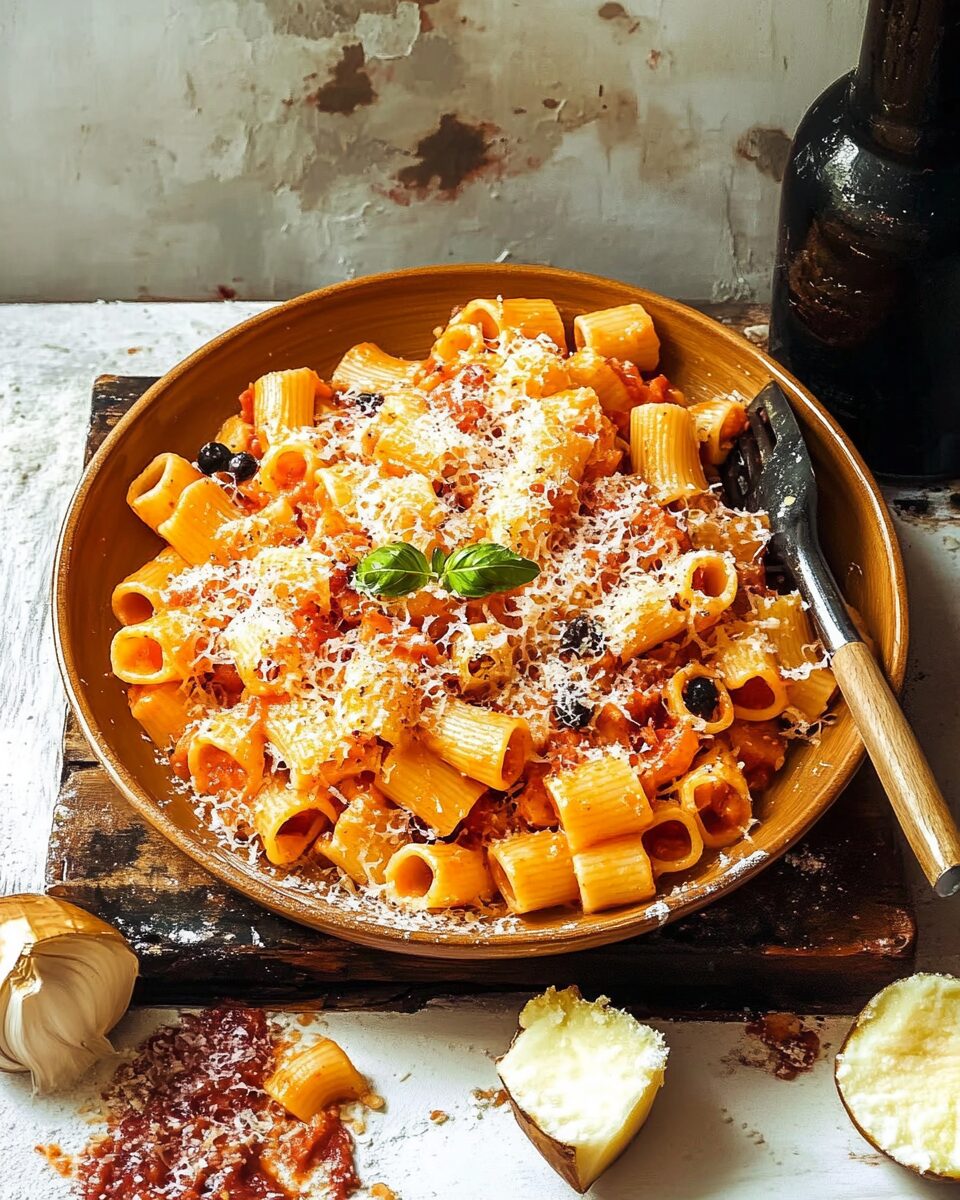Pasta all’Amatriciana is a classic Italian dish known for its bold, savory flavors and rich tomato-based sauce infused with guanciale (cured pork cheek), Pecorino Romano cheese, and a hint of spice from red pepper flakes. This traditional Roman pasta dish is simple yet incredibly flavorful, making it a favorite for weeknight dinners or special occasions. Pair it with a glass of red wine and experience authentic Italian comfort food at home!
Full Recipe:
Ingredients
-
12 oz spaghetti or bucatini
-
4 oz guanciale, diced (or pancetta as a substitute)
-
1 cup crushed San Marzano tomatoes
-
1/2 cup Pecorino Romano cheese, grated
-
1/2 tsp red pepper flakes
-
1/2 tsp black pepper
-
1 tbsp olive oil
-
Salt to taste
Directions
-
Cook the pasta: Bring a large pot of salted water to a boil. Cook pasta until al dente according to package instructions. Reserve 1 cup of pasta water before draining.
-
Prepare the guanciale: Heat olive oil in a large pan over medium heat. Add diced guanciale and cook until crispy and golden brown, about 5-7 minutes. Remove excess fat if necessary.
-
Make the sauce: Lower the heat and add red pepper flakes. Stir in crushed tomatoes, salt, and black pepper. Simmer for 10 minutes, stirring occasionally.
-
Combine everything: Add the drained pasta to the sauce and toss to coat. Gradually add reserved pasta water as needed for a smooth, glossy sauce.
-
Finish and serve: Stir in grated Pecorino Romano cheese, mix well, and serve immediately. Garnish with extra cheese if desired. Enjoy!
Nutritional Facts (Per Serving)
-
Calories: 480
-
Protein: 19g
-
Carbohydrates: 57g
-
Fat: 18g
-
Saturated Fat: 7g
-
Cholesterol: 30mg
-
Fiber: 4g
-
Sodium: 720mg
The History of Pasta all’Amatriciana
The origins of Pasta all’Amatriciana date back to the 18th century in the town of Amatrice, a small village in central Italy. The dish was originally prepared by shepherds who used locally sourced ingredients. The main ingredients were simple: pasta, cured pork, and Pecorino Romano cheese, which were easily accessible to the shepherds in the region. Over the years, as the recipe spread to Rome, tomatoes were incorporated into the dish, transforming it into the version we recognize today.
The dish was originally called “maccheroni alla gricia,” and it was only later, after tomatoes were added, that it became known as “Amatriciana.” This evolution of the recipe was largely influenced by the availability of tomatoes in the 18th century. Today, Pasta all’Amatriciana is recognized as a symbol of Italian culinary tradition and is enjoyed by people around the world. The use of guanciale is a key feature of this dish, providing an authentic and rich flavor that is distinctive to the Amatriciana recipe.
Key Ingredients and Their Significance
The hallmark of Pasta all’Amatriciana is its use of high-quality ingredients that come together to create a flavorful and satisfying dish. The following ingredients are essential to this recipe:
-
Guanciale: This Italian cured meat made from pork cheek or jowl is the star ingredient in Pasta all’Amatriciana. Unlike pancetta, which is made from pork belly, guanciale is known for its rich, delicate flavor and slightly fatty texture. It provides the dish with a deep, savory taste that cannot be replicated with other meats. Guanciale is typically seasoned with salt, pepper, and herbs, then cured for a few months.
-
Pecorino Romano Cheese: Pecorino Romano is a sharp, salty, and tangy cheese made from sheep’s milk. It is a staple in Roman cooking and adds a distinct flavor to the dish. Its robust taste complements the richness of the guanciale and enhances the overall flavor profile of the sauce.
-
Tomatoes: While tomatoes were not part of the original Amatriciana recipe, they have become an integral part of the modern version. The sweet and acidic nature of tomatoes balances the richness of the guanciale and brings a vibrant color to the dish. San Marzano tomatoes, known for their sweetness and low acidity, are often recommended for an authentic flavor.
-
Red Pepper Flakes: The inclusion of red pepper flakes provides a subtle heat that enhances the overall depth of the dish. The spice is not overpowering but adds a pleasant warmth that pairs beautifully with the smoky guanciale and the creamy Pecorino Romano.
-
Pasta: While fettuccini or spaghetti are the most common types of pasta used for this dish, the beauty of Pasta all’Amatriciana lies in its versatility. Bucatini, a thick pasta with a hollow center, is often considered the traditional choice, as its shape allows the sauce to cling to it perfectly.
Cooking Techniques for the Perfect Pasta all’Amatriciana
Cooking Pasta all’Amatriciana is an art form in itself. The key to making this dish successfully is in the delicate balance of flavors, and each step should be done with care. The guanciale should be rendered slowly to allow its fat to melt and infuse the sauce with its savory flavor. The tomatoes should be added only after the guanciale has been cooked to perfection, and the sauce should be simmered to allow the flavors to meld together.
One important tip is to use the pasta water when mixing the pasta with the sauce. The starchy water helps bind the sauce to the pasta and creates a silky texture that makes the dish more cohesive. Additionally, it’s important to add the Pecorino Romano at the end of cooking to avoid clumping and ensure it melts smoothly into the sauce.
Variations and Substitutions
While Pasta all’Amatriciana is traditionally made with guanciale and Pecorino Romano cheese, there are some variations and substitutions that can be made, depending on availability or personal preference. Here are a few suggestions:
-
Pancetta: If guanciale is not available, pancetta can be used as a substitute. Although pancetta is made from pork belly and has a slightly different flavor profile, it can still provide a similar savory richness to the dish.
-
Bacon: In a pinch, bacon can be used as a substitute for guanciale. However, bacon is generally smokier and saltier than guanciale, so it may alter the flavor of the dish slightly.
-
Cheese Substitutes: If Pecorino Romano is unavailable, you can use other hard, salty cheeses like Parmigiano-Reggiano. However, the taste will be less sharp and tangy than the traditional version.
-
Spaghetti or Bucatini: While bucatini is the traditional pasta used for this dish, spaghetti is a common alternative. The key is to use a pasta shape that will hold the sauce well, allowing each bite to be coated in the rich, flavorful sauce.
Health Considerations
Pasta all’Amatriciana, like many traditional Italian dishes, is best enjoyed in moderation. While it is a flavorful and satisfying dish, it is also rich in fat, calories, and sodium due to the use of guanciale and Pecorino Romano cheese. For those watching their caloric intake, it’s possible to make a lighter version by using leaner meats, such as turkey bacon or chicken sausage, and opting for a reduced-fat cheese. However, making these substitutions can alter the traditional taste of the dish.
Conclusion
Pasta all’Amatriciana is a timeless Italian classic that showcases the simple beauty of high-quality ingredients coming together to create a delicious and satisfying dish. With its smoky guanciale, tangy Pecorino Romano cheese, and vibrant tomatoes, this dish offers a perfect balance of flavors that will transport you straight to the heart of Italy. Whether you’re cooking for a weeknight dinner or preparing a special meal for friends and family, Pasta all’Amatriciana is sure to impress and leave everyone asking for seconds.






